Study Guide
Field 008: Earth Science
Sample Selected-Response Questions
Recommendation for individuals using a screenreader: please set your punctuation settings to "most."
General Test Directions
This test consists of two sections: 1) a section with selected-response questions and 2) a constructed-response section.
Each question in the first section is a selected-response question with four answer choices. Read each question and answer choice carefully and choose the start uppercase ONE end uppercase best answer.
Try to answer all questions. Even if you are unsure of an answer, it is better to guess than not to answer a question at all. You will start uppercase NOT end uppercase be penalized for guessing.
The second section of this test consists of one constructed-response assignment. You will be asked to provide a written response to the assignment. Directions for completing your written response to the constructed-response assignment appear immediately before the assignment.
You may start uppercase NOT end uppercase use any type of calculator or reference materials during the test session.
Sample Selected-Response Questions
Competency 0003
Understand the process of scientific inquiry and the role of observation and experimentation
in explaining natural phenomena.
1. A seismologist is planning an investigation into earthquake behavior in a particular region. The seismologist applies the theory of plate tectonics and formulates a hypothesis for regional earthquake behavior that is consistent with that theory. The seismologist can be confident about using the theory of plate tectonics as the foundation for this investigation because the theory:
- has been proven as fact.
- is supported by a great deal of empirical evidence.
- needs no further revision.
- supports the desired conclusions.
correct response: b.the theory of plate tectonics provides a unifying framework that helps explain diverse geologic phenomena. this theory—that large plates of the lithosphere move slowly around on the earth's surface—was developed as a result of evidence gathered through careful scientific observation and measurement of phenomena such as magnetic patterns on the ocean floor, locations of earthquakes and volcanoes, and the structure and shape of the continents. as new data are gathered, certain elements of the theory may be refined, but the idea that geologic phenomena can be explained in terms of moving plates is fundamental to the study of modern geology.
Competency 0005
Understand types and uses of natural resources, the effects of human activities
on the environment, and the need for stewardship to preserve the environmental integrity
of the earth's ecosystems.
2. A town has detected nitrates in its water supply, which is drawn from a reservoir and from a number of wells that tap a small aquifer. The nitrates have been traced to wells in one area. Which of the following is the most likely source of the contamination?
- leakage from underground gasoline storage tanks
- ash and particulates from upwind industrial stacks
- leachate from naturally occurring minerals
- runoff from farms and feedlots
correct response: d. nitrates are nitrogen-containing compounds, which are significant components of manufactured fertilizers and animal wastes. these fertilizers and wastes can enter the surface water that runs off of fields where crops are grown and locations where animals are kept in large concentrations. some of this surface water, along with the nitrogenous compounds dissolved in it, can percolate through the ground, thus introducing nitrates into the water source that supplies the wells.
Competency 0008
Understand the structure, composition, and features of the earth, moon, and sun
and the role of technology and exploration in obtaining knowledge about the earth,
moon, and sun system.
3. At a location in Utah, core samples have been taken of sedimentary rocks that formed in a tidal area nearly one billion years ago. These rocks have bands that scientists believe were formed by tides. The bands indicate that at the time the sediments were laid down, the lunar month was shorter than it is now. They also suggest that the length of a day was about 21 hours. Which of the following conclusions are supported by these observations?
- Roman numeral 1. The moon was once closer to the earth than it is now.
- Roman numeral 2. The earth once tilted less on its axis than it does now.
- Roman numeral 3. The orbit of the moon was once more elliptical than it is now.
- Roman numeral 4. The earth once rotated faster on its axis than it does now.
- roman numeral 1 and roman numeral 2 only
- roman numeral 1 and roman numeral 4 only
- roman numeral 2 and roman numeral 3 only
- roman numeral 3 and roman numeral 4 only
correct response: b. since the duration of the lunar month is determined by the duration of the moon's revolution around the earth, a shorter lunar month would be possible if the moon were closer to the earth, since in this case the moon's path around the earth would be shorter. likewise, since day length is determined by the length of time it takes the earth to make one rotation on its axis, a shorter day would be possible if the earth turned on its axis more quickly.
Competency 0011
Understand stars, their motions and life cycles, and the methods and technology
used to study them.
4. An astronomer observes that the light coming from a distant star is shifted toward the red end of the visible spectrum. The best interpretation of this information is that the:
- star is increasing in diameter.
- temperature of the star is increasing.
- distance between the star and the earth is increasing.
- star is outside our galaxy.
correct response: c. a shift toward the red end of the spectrum in the light coming from the star indicates that the wavelengths are becoming longer. this observation can best be explained by the doppler effect, which describes changes in wavelength due to the relative motion of a light source and observer. in this instance, relative motion of the star away from the earth causes the wavelengths to elongate and shift toward the red end of the color spectrum.
Competency 0012
Understand evidence regarding the size, structure, scale, and motions of the universe,
the Milky Way galaxy, and the solar system.
5. Some scientists believe that the solar system was formed from condensation of a rotating disk of gas and dust debris produced by a supernova explosion. Which of the following hypothetical discoveries would be the strongest evidence start italics against end italics this theory?
- A tenth planet is found that orbits the sun in a direction opposite to that of the other planets.
- The asteroids in the asteroid belt are found to be remnants of an ancient planet.
- Studies indicate that the solar system is more than twice as old as previously thought.
- A moon of Jupiter is found to be a captured asteroid.
correct response: a. the central idea of the "big bang" theory is that all the planets in the solar system formed from a rotating disk of gas and debris and that this is the reason that all the known planets orbit in the same direction. a planet orbiting in the opposite direction would contradict this theory, so if a planet that orbits in the opposite direction were to be discovered, the validity of the theory would be called into question.
Competency 0014
Understand the properties of water, conditions in the atmosphere that favor phase
changes, and the energy relationships among phase changes, cloud formation, and
precipitation.
6. A cumulus cloud begins to form in a warm air mass that is ascending rapidly through a slightly cooler air mass. Which of the following is the most likely cause of the condensation in the warm air mass?
- a decrease in temperature caused by a decrease in atmospheric pressure
- a decrease in temperature caused by heat exchange between the two air masses
- an increase in relative humidity caused by an increase in water content
- an increase in relative humidity caused by an increase in the dew point
correct response: a. air pressure decreases with increasing altitude, so an air mass that is ascending will be subject to lower pressure and will expand. the result of the expansion of the air mass is that the air molecules move farther apart, collide less often, and subsequently produce less heat. this leads to a decrease in the temperature of the air mass. this process is called adiabatic cooling. as the rising air mass cools, the water vapor contained in it begins to condense and form clouds because colder air can hold less water vapor than warm air.
Competency 0015
Understand characteristics of broad-scale weather systems and local weather, the
relationship between them, and the methods and instruments used to collect and display
weather data.
7. Which of the following most accurately represents the air circulation patterns likely to develop on a hot summer afternoon in a coastal area?
Each response is a diagram of air flow over land and water. The water, labeled Sea, is to the left, and the land is to the right. A label and arrow indicate that the tide is going out. The key indicates that a dashed line is cold air and a solid line is warm air.
-
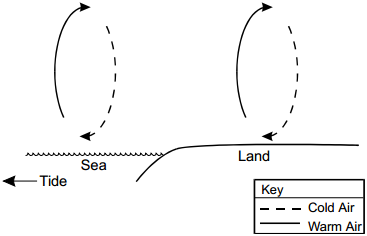 Over the sea, warm air moves up and cold air moves down
in a clockwise pattern. The same pattern is shown over the land.
Over the sea, warm air moves up and cold air moves down
in a clockwise pattern. The same pattern is shown over the land. -
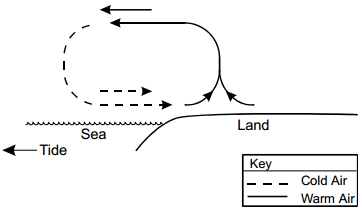 Over the land, warm air rises from the land and the
edge of the sea and moves out over the sea. Over the sea, cold air moves down and
toward the land. Together they form a counterclockwise pattern.
Over the land, warm air rises from the land and the
edge of the sea and moves out over the sea. Over the sea, cold air moves down and
toward the land. Together they form a counterclockwise pattern. -
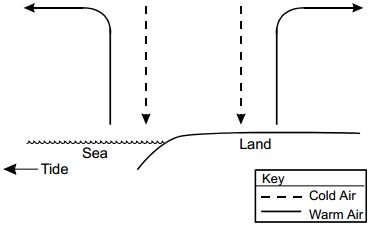 Over the sea, warm air rises and moves further out
to sea. Closer to land, cold air moves down toward the water. Over the land, warm
air rises and moves further inland. Closer to the water, cold air moves down toward
the land.
Over the sea, warm air rises and moves further out
to sea. Closer to land, cold air moves down toward the water. Over the land, warm
air rises and moves further inland. Closer to the water, cold air moves down toward
the land. -
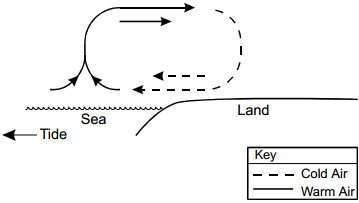 Over the sea, warm air rises from the sea and the
edge of the land and moves inland. Over the land, cold air moves down and toward
the sea. Together they form a clockwise pattern.
Over the sea, warm air rises from the sea and the
edge of the land and moves inland. Over the land, cold air moves down and toward
the sea. Together they form a clockwise pattern.
correct response: b. on hot summer afternoons in coastal areas, the land heats more quickly than the nearby water. the warm ground also heats the air above it, which creates a thermal low over the land. the air over the water remains cooler, creating a thermal high. this pressure gradient causes the denser, cooler air over the water to move inland along the surface, resulting in a sea breeze. the less dense warm air over the land rises and moves out over the water, where it cools and sinks back to the surface.
Competency 0019
Understand geochemical systems, the processes of mineral and rock formation, the
characteristics of different types of minerals and rocks, and the methods used to
identify and classify them.
8. A geologist observes that although the same minerals are present along the two-mile length of an escarpment, the size of the mineral crystals increases from west to east along the escarpment. Which of the following would best explain this observation?
- The escarpment is metamorphic. The greatest heat and pressure occurred at the western end.
- The escarpment is sedimentary. The eastern end is older than the western end.
- The escarpment is igneous. The western end cooled more quickly than the eastern end.
- The escarpment is metamorphic at the western end and igneous at the eastern end.
correct response: c. the crystal size in igneous rocks is influenced by the rate at which the molten rock cooled. when magma cools slowly, ions can migrate more readily, resulting in the formation of large crystals. by contrast, when cooling occurs rapidly, ion movement is inhibited, resulting in smaller crystals.
Competency 0022
Understand characteristics of the major geologic time divisions and theories and
supporting evidence regarding the earth's geologic history.
9. start bold Use the diagram below to answer the question that follows. end bold
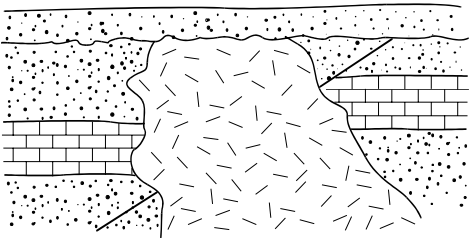
The diagram shows a cross section of several geological layers of land. The bottom layer shown has a granular pattern. A diagonal line passes through it from lower left to upper right. The bottom layer is interrupted by an irregular shape protruding from the bottom of the diagram through three layers of material. The irregular shape has a pattern of random lines. To the right of this shape, the bottom layer is shifted up. The next layer has a bricklike pattern. It is also shifted up to the right of the irregular shape. The next layer has a granular patter and is also shifted up on the right. The diagonal line that is seen in the bottom layer to the left of the irregular shape continues here through part of the bricklike layer and the rest of the granular layer. The top layer is also granular and is of a uniform thickness all the way across.
Based on the cross-sectional diagram above, which of the following was the likely sequence of geologic events?
- sedimentation then intrusion then erosion then faulting then sedimentation
- sedimentation then faulting then intrusion then erosion then sedimentation
- sedimentation then folding then faulting then erosion then sedimentation
- sedimentation then erosion then sedimentation then erosion then faulting
correct response: b. the formation of the lower three sedimentary layers preceded their displacement by the fault. the igneous intrusion occurred after the faulting, as is evident by the fact that it cuts across the fault. the flattened top of the intrusion suggests that it was exposed on what was once the surface and underwent erosion. finally, another sedimentary layer was deposited over the entire area.
Competency 0024
Understand the processes by which water moves on and beneath the earth's surface.
10. A confined aquifer supplies a large number of gushing artesian wells in a small town. As the town grows and new wells are drilled, many of the wells begin to flow more slowly or stop flowing altogether. Which of the following is the most likely explanation?
- The limited supply of water originally contained in the aquifer has been depleted.
- Over time, the aquifer has gradually changed its position relative to the town.
- Over time, the aquifer's underground pressure was increased by the town's wells.
- The town's water use has grown to exceed the aquifer's recharge rate.
correct response: d. both the capacity and the recharge rate of an aquifer are finite. in the situation described, the number of wells in the town was originally small enough that the rate at which water was withdrawn from the aquifer did not exceed its recharge rate. as the number of wells increased, however, the rate of withdrawal from the wells exceeded the recharge rate, thus reducing the hydrostatic pressure in the aquifer and reducing the flow to the wells.
